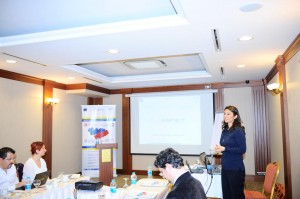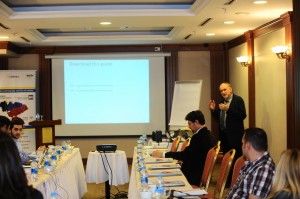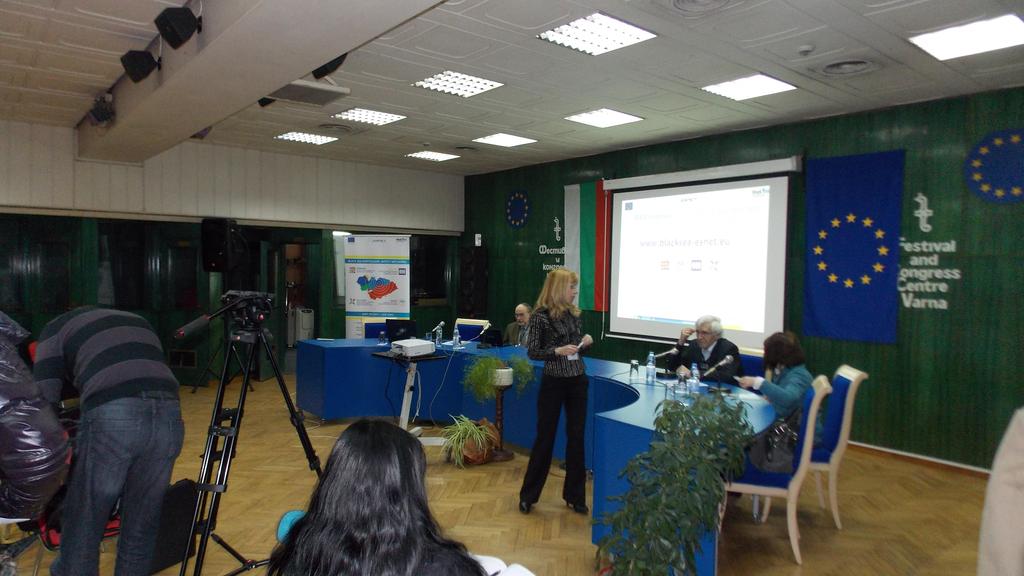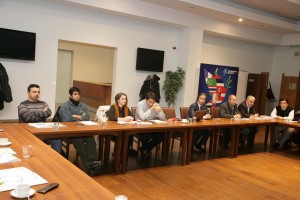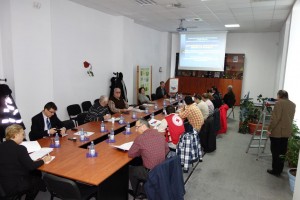- Date : 27 – 28 September 2012
- Place : Istanbul (Turkey)
- No. Participants: 29 (14 from TR, 5 from RO, 5 from BGR, 5 from MLD)
Within the scope of Activity Group 1, regional workshop was organized in Istanbul by IPA partner with the participation of project partners and the stakeholders. The workshop organized at regional level with the purpose of working on country assessment reports comments,definitions of regional networking needs, the elaboration of “Black Sea seismicity monitoring andearly warning systems alignment plan” and initiation of future training outlines.
The workshop was organized in consecutive two days, on the dates of 27th and 28th September 2012 in Boğaziçi University Kandilli and Istanbul Aydın University Florya Campuses considering the related workshop topic titles. The workshop was attended by each project partner and their stakeholders. In total 29 participants (14 participants from TR, 5 participants from RO, 5 participants from BGR, 5 participants from MLD), from 11 Institutions participated the workshop.
In the workshop the technical aim was putting together the work developed by each partner in its respective country, and in this way ensuring the joint character of the project activities. End of the workshop it was also aimed to obtain the expected outcomes of :
- Defining the country based ommon needs related to the sector
- Drafting the “Black Sea Seismicity Monitoring and Early Warning System Alignment Plan”,
- Dead-lining the development of plan within 2 months after the Regional Workshop,
- Assessing the training needs of involved bodies from participating countries,
- Developing a training plan after the assessment.
On the first day the workshop was opened and welcomed by the Deputy Director of KOERI, Prof.Dr.Nurcan Meral ÖZEL, the background, objectives an outcomes of the regional workshop topics were presented by IPA project Manager Ms.Nalan ÜKER, ESNET project objectives, activities, outcomes and its current situation was presented by ENPI project manager Dr.Stefan BALAN.
In the workshop as it was planned and projected based on the findings of each national assessment, common needs were defined under consensus of project partners and the “Black Sea seismicity monitoring and early warning systems alignment plan” was drafted. The draft plan contained two main chapters that defined as “technical” and “operative”, with 16 search sections. The technical part contained more scientific and seismological titles such seismic data sharing, geodetic information, seismic network issues and operative part included more operational titles such strengthening coordination skills, dealing with community based organizations and local authorities, development of a capacity building curricula, public awareness, uniform the terminology in the sector.
In the workshop investigations on country assessment reports were presented in order of RO, TR, BGR and MLD by NIEP, KOERI, BAS and IGS. In the workshop definitions of regional networking needs and defining the characterize and content of the “Black Sea Seismic Monitoring and Early Warning Alignment Plan” topics were discussed with the special research, case presentations and focus group discussions.
In the workshop as it was also projected the capacity building training needs of involved bodies from participating countries were assessed and turned into a training plan.
On the first day of the regional workshop the presenters were: Prof.Dr.Nurcan Meral ÖZER, Prof.Dr.Ali PINAR, Dr.Didem SAMUT, PhD students Ms.Özge ZÜLFİKAR, Ms.Zeynep COŞKUN and Ms.Esra ŞAHİN from TR, KOERI, Dr.Stefan BALAN and Dr.Dragos TATARU from RO, NIEP, Assoc.Prof.Dr.Lilya DIMITROVA from BGR, BAS, Dr.Alcaz VASILE from MLD, IGS.
On the second day of the regional workshop the mainly training needs of involved bodies from participating countries were assessed and turned into a training plan. In the workshop initiating and assessing the capacity building training needs were presented for all project countries by AFAM Director Asst.Prof.Dr.Kubilay KAPTAN. The sessions conducted with free discussions and brain storming on the alignment plan.
On the second day of the regional workshop the presenters were: Ms.Liliana Isebella PISCANU from Romania, Constanta County Management of Emergency Situations Inter Institutional Coordination and Cooperation Mr.Tudor TACHE from Romania, Constanta County Inspectorate for Emergency – Head of Fire Prevention Mr.Vitali MUTAF from Republic of Moldova, National Emergency System and Applications
End of the workshop it was decided to complete the plan with the following main directions:
All the workshop expenditures were such materials, catering services were covered from IPA partner and its budget including partners and the stakeholder institutions representatives’ international and local travel and accommodation expenses.
- Research, seismology, geology, tectonics etc. of the eligible regions of the project,
- Monitoring systems of the ESNET countries (seismic, GPS and OBS),
- Post seismic actions (involved institutions, actions plans, resources, training of involved
bodies etc.)
- Early Warning Systems in ESNET countries (existing systems, possibilities of installing such
devices, limits of such systems depending on the type of earthquakes, resources, trainings and
etc.)













